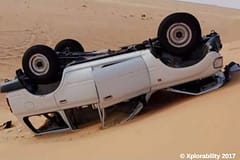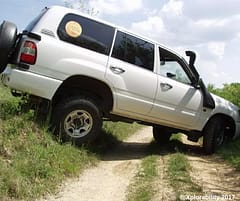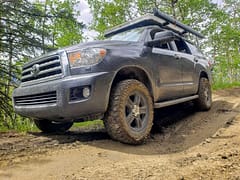On-Road Rollovers
Reduce the Likelihood of a Vehicle Rollover
Contents
Introduction
What is the cause of on-road rollovers?
Remember what Newton’s 3rd Law of Motion states: For every action, there is an equal and opposite reaction
When driving, whether it be On-Road or Off-Road, if the vehicle tilts at an angle from a maneuver such as losing a wheel off the edge of the road or into a rut, ditch or even just a variance in the terrain the driver will usually immediately react to this. Here are tips on what you can do to reduce the likelihood of a rollover. [Off-road rollover tips(/off-road-rollovers) are in the next article.
This content was developed by and owned by Paul Sinkinson, Xplorability owner. Paul is a 4wd Defensive Driver Training Consultant/Trainer and Programme Developer.
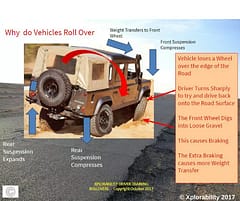
The “Phenomena” that causes driver quick reaction is that the brain senses the change and with confirmation from what the eyes are seeing, it reacts to the fact that the vehicle is no longer level.
When this happens, because the driver is seated with legs and feet in the foot-well and seat belt holding the upper body, after trying to contra the tilting motion and finding that this is limited, the only controllable parts of the body are the arms and his hands on the steering wheel.
With most of the body “trapped,” the reaction of the driver is to turn the wheel to contra. It is similar to a Yachtsman leaning out when the boat tilts over.
As soon as the steering wheel is turned to contra that can be when the trouble starts and a Rollover may become inevitable.
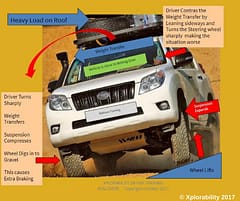
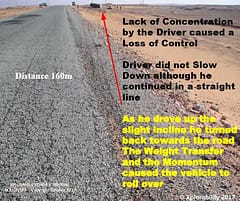
What Can You Do to Reduce the Likelihood of a Rollover?
On-Road Rollovers: Straight Roads
Usually, On-Road Rollovers on Black Top Tarmac or Gravel Roads are caused by lack of concentration or a distraction when driving long straight roads and too much speed when driving corners.
Losing a wheel off the edge of the road surface onto a softer surface can create a braking effect as the front wheel digs in as mentioned earlier if the driver contras and turns back to the road surface.
If you lose a wheel off the edge of the road surface DON’T TURN BACK!
Assuming you are not endangering the vehicle and life, DON’T BRAKE!
Take your foot off the accelerator which reduces the speed, steer in a straight line to maintain stability and allow the vehicle to slow naturally although, IF in a straight line you can GENTLY start to apply the brakes until the situation is recovered. Now relax, check the vehicle for damage before continuing your journey.
On-Road Rollovers: Corners
Rollovers occur more regularly on corners than other situations. This is because the vehicle dynamics are already under stress. Add speed and road surface conditions and it is easy to de-stabilize things.
Over-Steer on Corners:
Over-Steer occurs when you have too much speed for the road conditions and perhaps turn into the corner too quickly. When you do this, the rear tyres lose traction and the vehicle slides out with a combination of weight transfer and centrifugal force and tries to overtake the front. The natural driver reaction is to contra this but self preservation also usually leads to braking. Braking causes more weight transfer forwards, the rear becomes lighter and the the driver is likely to lose directional control so the vehicle leaves the road. As this happens, the wheels with most weight on them dig into the softer verges and weight transfer creates the rollover situation.
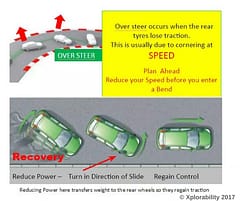
Under-Steer on Corners:
Under-steer occurs usually due to the driver turning into the apex of the corner too sharply when going too fast. Although the steering wheels are turned, due to the acceleration/speed, weight is being transferred to the rear wheels so the front tyres lose adhesion. When this happens, momentum carries the vehicle onwards in a straight line.
What follows normally is that the vehicle leaves the road surface and because the front wheels are already turned to take the corner, as soon as they land on a softer surface they dig in. More weight transfer occurs causing a braking effect with the resultant rollover.
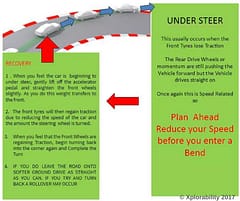
Previous Article: Gravel and Country Roads
Next Article: Off-Road Rollovers
Next Article: Off-Road Rollovers
Check out other work by Paul, fiction thriller novels here.
Copyright
This content was prepared for the Off-Road Discovery Website by Xplorability 4wd Training
The Content - All Photographs and Photographic Copyright and All other Rights other Reserved October 2017. S.W. France This content may not be copied or reproduced without the written consent of Paul Sinkinson – Xplorability Training.
For Use Only in 4wd and Light Vehicle Driver Training.
Not for Re-Publication, Distribution or use outside the Xplorability Training Programme
